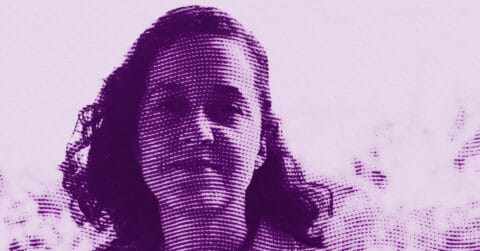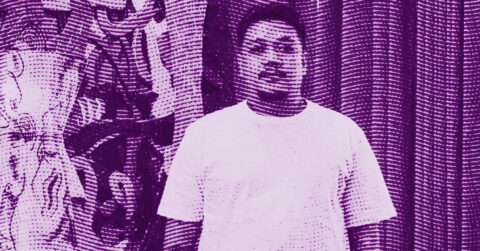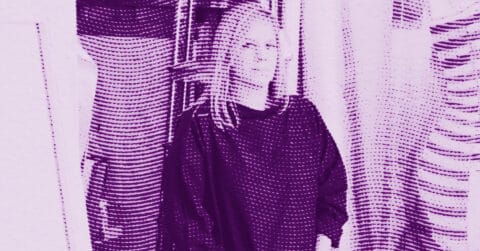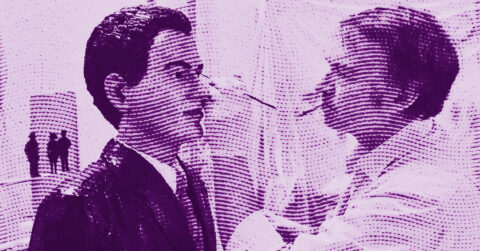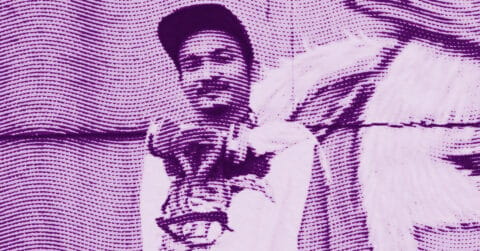Listen to me carefully, you bunch of snobs. Albert Janzen, this artist born in Siberia and living in Berlin, has nothing to do with your little certainties about contemporary art. If you think that drawing lines is within the reach of the first child, it is because you have understood nothing about art, nor about life for that matter. Janzen does not mess around with the conventions, he pursues his path with the aplomb of a logician mathematician become master of linear abstraction.
This artist spent thirteen long years at the School of Arts and Music in Berlin before pursuing studies in philosophy and mathematics. An atypical path that shapes a singular gaze. While you others flutter from one artistic trend to another like flies attracted by glittering novelty, Janzen has chosen the path of absolute purity: the line.
The line. This fundamental element of our visual perception, so basic that it becomes invisible through its omnipresence. Janzen reminds us of its capital importance: “Lines are part of the most intuitive means of perceiving and understanding our environment. Each recognition of visual structures depends on a recognition of lines” [1]. It is with this quasi-monastic obsession for the line that he won the prestigious Luxembourg Art Prize in 2015, propelling his career onto the international scene.
What strikes in his work is this fierce determination to make the line a self-sufficient entity. “I draw lines not to build something, but to draw lines. The shapes and patterns that appear in my drawings have no other purpose than to reveal the movements of the lines” [2]. This self-referentiality might seem narcissistic or meaningless, but it is in reality deeply rooted in the Western philosophical tradition.
For indeed, behind the apparent simplicity of these intertwinements of black lines on a white background lies a metaphysical reflection on the very nature of perception and reality. Janzen is not just a draftsman, he is a thinker who uses the visual medium to explore fundamental questions. Galileo, this giant of science, wrote that “The Universe (…) is written in the mathematical language, and its characters are triangles, circles, and other geometric figures, without which it is humanly impossible to understand a word. Without them, it is a vain wandering in a dark labyrinth [3]. Is this not exactly what Janzen shows us through his abstract compositions? That the world is structured by lines, that our understanding of reality necessarily passes through the identification of linear structures, contours, limits, borders?
When Janzen draws his lines on a Velleda board, in ink on paper or digitally on Photoshop, he does not just produce aesthetically pleasing images. He invites us to an active meditation on our way of apprehending the world. His lines are never perfectly straight, they undulate, cross, avoid each other, merge. They are like the thoughts that cross our minds: sometimes ordered, often chaotic, always in motion.
It is no coincidence that this artist also studied logic in Amsterdam. Logic, the discipline interested in the formal structures of reasoning, shares with Janzen’s art a common quest for purity. But where logic seeks to eliminate ambiguity, Janzen’s art embraces it fully. His drawings are of absolute clarity in their composition and of infinite ambiguity in their interpretation.
Take one of his works like “No title” from 2015, this immense unique photograph of an ephemeral drawing on a whiteboard. At first glance, it is just an intertwining of black lines. But look longer, and you may see capillaries, seaweed, jellyfish, tissues, cosmic images. Or perhaps you will see nothing but lines, and that is perfectly sufficient. That is all the beauty of abstraction: it imposes nothing, it proposes everything.
Janzen is part of an artistic tradition that includes Cy Twombly, Gerhard Richter, Zao Wou-Ki, and Antonio Murado. But he brings something fundamentally new: an intellectual rigor that is not unlike that of a Ludwig Wittgenstein. The Austrian philosopher wrote in his Tractatus Logico-Philosophicus: “The limits of my language mean the limits of my world” [4]. Janzen could paraphrase: “The lines of my drawing mean the limits of my perception”.
This conception of art as an exploration of cognitive limits is particularly evident in Janzen’s approach. He does not content himself with producing images, he questions our very capacity to see, to perceive, to understand. In this sense, his work is profoundly philosophical, not in the academic sense of the term, but in its essential questioning of the nature of human experience.
And it is doubtless for this reason that his works are so captivating despite, or perhaps thanks to, their apparent simplicity. They refer us to our own mechanisms of perception. Faced with his lines that seem to extend infinitely beyond the edges of the canvas or paper, we are invited to question the very nature of our vision of the world.
There is something deeply contemplative in Janzen’s art. Not this passive and beatific contemplation that is found too often in spiritual art, but an active, engaged, almost scientific contemplation. Observing his works is participating in a perceptual experience that makes us aware of our own cognitive processes.
This experimental dimension of his work echoes David Davies’ aesthetic theory, which conceives art as a process rather than a finished product. In his work “Art as Process”, Davies argues that every work of art would be the “focus of appreciation” of a prior process. In other words, what is really interesting in a work is not the final object, but the process of creation that gave birth to it.
Janzen’s art perfectly illustrates this processual conception. When we look at his drawings, we cannot help but wonder about their genesis. With which line did he start? Where is the last one? When and why did he decide to stop? How long did the creation last? Did the thread of his thought follow the same directions as his lines? Do his compositions reflect emotional states, or rather a calm meditation aspiring to emptiness?
These questions are all the more relevant as some of his works are by nature ephemeral. His drawings on Velleda boards exist only in photographic form. The process of creation is over, the result has disappeared, only the documentary trace remains. This temporal dimension of his work adds an additional layer of meaning. Janzen’s art is not frozen in time, it is time itself made visible.
One could see a metaphor for the human condition: we spend our lives drawing lines, creating connections, establishing paths, but all this is doomed to disappear. Only traces, memories, yellowed photographs will remain. This acute awareness of impermanence gives Janzen’s work an existential depth that goes far beyond the formal exercise.
But let us not be carried away by considerations too dark. There is an undeniable joy in Janzen’s work, a celebration of the creative act in its purest form. His lines dance on the surface, freed from all representative constraint. They exist for themselves, in a state of grace that recalls the innocence of childhood, when drawing was not yet subject to aesthetic judgment or the imperative of resemblance.
This freedom is precisely what Janzen defends through his art: “My images represent the independence and freedom of being and thought. I invite the viewer to see the line as an independent being and to free it from its usual function as a fundamental tool of representation” [5]. It is a call for the emancipation of our gaze, for a form of perception that is not dictated by conventions or expectations.
In this sense, Janzen’s art is profoundly political, not in the trivial sense of an engaged art that takes a position on specific social issues, but in the fundamental sense of a questioning of the dominant modes of perception and thought. By inviting us to see the line as an autonomous entity rather than a simple tool of representation, he encourages us to rethink our relationship to the world, to see beyond the functions attributed to things and beings.
“In general, when we perceive our environment outside of its function, we train our independent thought. For its function generally corresponds to ideas that others have assigned to it” [6]. This statement by the artist reveals the critical dimension of his work. It is not just a matter of producing aesthetically pleasing images, but of proposing an alternative to the dominant modes of perception, a form of resistance to the standardization of thought.
This approach is part of a long tradition of abstract art as an act of resistance. From Kandinsky and Malevich to American abstract expressionism, abstraction has often been a means of opposing authoritarian regimes, aesthetic dogmas, social conventions. Janzen’s art continues this tradition while updating it for our time, where the standardization of modes of thought takes more subtle but no less oppressive forms.
It is interesting to see how an artist can, through a means of expression as minimalist as the line, address questions as complex as freedom of thought, the structure of perception or the nature of reality. This is doubtless the sign of authentic talent that can, with so little, say so much.
So, of course, you could shrug your shoulders and say that they are only lines, that anyone could do the same. But that would be missing the essential. Janzen’s art is not in the technical difficulty of its realization, though try to do the same, but in the conceptual depth that underlies it. It is not a question of knowing if it is difficult to do, but if it is important to think.
And that is where the strength of his work lies: it makes us think. It makes us reflect on the way we perceive the world, on the way we construct meaning from simple lines. It reminds us that our understanding of reality is always mediated by perceptual structures that we have integrated without even being aware of it. The art of Albert Janzen is an invitation to freedom. Freedom of perception, freedom of thought, freedom of interpretation. In a world that is increasingly standardized, algorithmized, where every image must correspond to a canon, where every thought must fit into a pre-established framework, his free, sinuous, undisciplined lines are a salutary reminder that art, like life, cannot be confined to boxes.
And that is perhaps what ultimately makes his work valuable: not its formal beauty, its conceptual complexity or its originality, but its ability to make us a little freer. A little more attentive, too, to the lines that structure our daily life, those lines that we no longer see because we cross them every day.
The next time you see a drawing by Albert Janzen, do not just examine it distractedly before moving on to the next one. Take the time to follow with your gaze each of his lines, to lose yourself in their meanders, to let yourself be surprised by their unexpected intersections. And perhaps, then, you will understand what the artist is trying to tell us: that the line, like life, has no other purpose than itself, and that is precisely what makes it beautiful.
- Albert Janzen, artist statement, 2015.
- Ibid.
- Galileo, Galileo’s The Assayer, presented and translated into French by Christiane Chauviré, Les Belles Lettres, ‘Annales littéraires de l’université de Besançon,’ 1979, p. 141.
- Ludwig Wittgenstein, Tractatus Logico-Philosophicus, proposition 5.6, French translation by G. G. Granger, Gallimard, Paris, 1993.
- Albert Janzen, interview with Singulart, 2018.
- Ibid.




